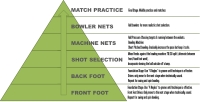10 Best Cricket Coaching Books for eReaders
More people than ever woke up on Christmas morning to a Kindle eBook reader. Who knows how many millions got their hands on an iPad or other tablet with a Kindle app ready to go.
Great gifts, but you need something to put on them.
Fixing Fast Bowlers: Curing Excessive Side Bend

We now know that the most significant cause of spinal stress fractures in fast bowlers comes from excessive side bend, or "lateral flexion" in scientific speak. This is often caused as a result of the body compensating in the delivery stride for things that have not worked correctly further back.
This could be the angle of approach, the angle of bound or misaligned back foot contact.
However, we sometimes get a situation where all of the above are OK and the bowler is still displaying excessive side bend at point of release.
So what can we do about it?
Here is my solution:
What Denmark Can Teach You About Coaching Cricket

Picture the scene; there I am, delivering my message to a committed and excellent group of cricket coaches in Denmark when the following points go up on my Keynote speech under the banner of "Batting non-negotiables":
1st response when ball hits pad or body is to think "run".
1st response to mid off and mid on is to think "run".
Fixing Fast Bowlers: Back Foot Contact

This is the first series of troubleshooting to repair inefficient or physically dangerous fast bowling technique.
The bowling action is complex and prone to breaking down. While we want bowler's to bowl with natural actions, in many cases when we see a flaw we will be quick to try to iron out. This is because injury, and reduction in pace and performance is often associated with the flaw.
One of the most common of these flaws is; as a bowler comes out of her bound and into her back foot contact (BFC). We often see the back leg sweeping underneath the body and then land in a position towards the return crease. As the action is a chain of events only one thing can happen: A misalignment between BFC and front foot contact (FFC).
Build a Fielding Culture

Have you ever said or thought any of these things as a coach?
"Fielding is a non-negotiable"
"Catches win matches"
"Fielding is the only time that we are working together as a team, so it's vital that we are good at it!'
I agree, but I also ask: How well does your coaching fielders and keepers reflect those statements?
How much are the players developing their basic stop, catch and throw skills so that your team fielding drills increase in quality?
After all, the better these drills are performed the better our chances of wickets in matches.
Cricket Infographic: The Pyramid of Batting Coaching
 Gary Palmer has been coaching batsmen for decades and alongside running the high-class CCM Academy, acts as a batting consultant to many professional and International batsmen. To find out more click here.
Gary Palmer has been coaching batsmen for decades and alongside running the high-class CCM Academy, acts as a batting consultant to many professional and International batsmen. To find out more click here.
Don't underestimate the power of coaching the basics well.
Think of good progressive coaching in building blocks: keep building the pyramid from the bottom up. It takes much longer to get it right unless you technically prepare players for the next level.
Coach the Intention

I spent some time in Switzerland last week with two guys who have mastered coaching people. I call them my 'Yodas' after the wise teacher in Star Wars.
One of their major sayings is:
"coach the intention; rather than the action".
What happens to people when they are coached to concentrate on specific (and often multiple) movements and actions?
Do people become more fluent or more 'clunky' in their movements?
Do you see the body move as one (like in a David Gower back foot drive or a KP clip through midwicket) or do we see the player move in separate parts, screw up their face and speak in words of discomfort?
I know the look of a player who I have given actions too as I have done that most of my career, it's a common look, trust me!
So over the last year or so, as I have connected more with the approaches of my two 'Yodas' and noticed a shift in each players movement patterns. I see less screwed up faces and sense that the players are developing faster than at any other time in my coaching lifetime.
So how does it work?
Use A "Management Team" to Build the Indestructable Cricket Club

You might not realise, but your side has a management team.
We don't have the professional luxury of a huge support staff containing physiotherapists, sports psychologists, analysts and assistant coaches like the major international outfits. We do have have a group of people who shape our performance on and off the field.
And it's the coaches job to manage this team, or it will manage itself: badly!
Good Cricket Coaches Know What to Say, Great Cricket Coaches Know When to Shut Up
 One of the best tools a cricket coach can use is the ability to say nothing at all.
One of the best tools a cricket coach can use is the ability to say nothing at all.
I can hear the nay-sayers already baulking. How can you possibly improve players if you stands at the back of the net in stony silence throughout a session? Of course, you can't and shouldn't do that. But you also need to work hard at knowing what to say, when to say it, how you say it, and - most importantly - if you need to say it at all.
Free Poster Reveals How to Create a Positive Cricket Culture
Creating a positive culture in cricket is tough because it's an idea that needs complete buy in. How do you make it easy for cricketers to understand the key elements?
Simple, you print out this poster and pin it up.
It's totally free for you to use and has been produced in association with Ryan Maron's Cape Town International Cricket Academy. You can find out more about how the Academy can help you gain the cricket experience of a lifetime by clicking here.
Using a simple mnemonic and hand signals, nobody can have the excuse that they didn't know the fundamentals of a positive culture of cricket. It's certain to give you the culture you desire where you play.
Here is that poster (click to enlarge):

